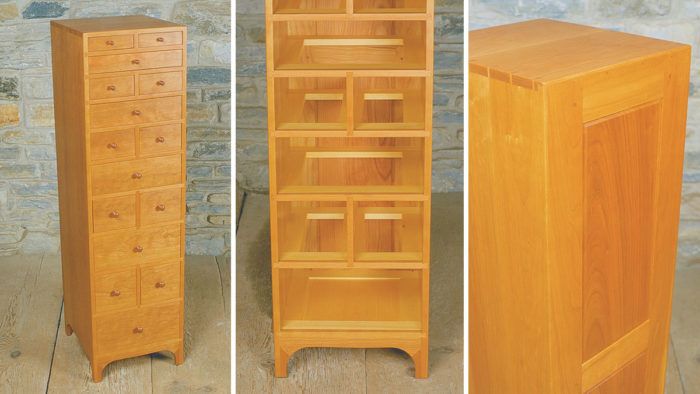Building a Chest of Drawers
Joinery and design considerations
Synopsis: Christian Becksvoort discusses the decisions and process involved in designing and building a chest of drawers and presents some of the methods he employs. First, he evaluates what will be stored in the chest and where it will go. He dimensions out the piece and builds proportions around drawer depth, and he prefers to join them with dovetails, though he talks about other options. He describes how moldings define edges and set off a piece, and he describes step by step how he goes about building one. Extensive drawings show various design options, and Becksvoort shares assembly tips and drawer-stop tricks.
Anyone who has worked with wood knows that building a piece of furniture involves a series of decisions, from choice of wood, to design and construction details, to selecting the final finish. Even if you build identical pieces over a period of years, you’ll probably find yourself making small changes each time—perfecting the proportions, or perhaps just exploring different joineries. In this article, I’ll discuss the range of decisions and processes involved in designing and building a chest of drawers, as well as presenting some of the methods that I employ.
One of the first things to consider in designing a chest—and perhaps the most subjective part of design—is the chest’s overall appearance. You should style the piece to suit your tastes or to fit into the decor of the room the chest will inhabit. Since I live near one of the last two Shaker communities and have restored several original Shaker pieces, my designs show the strong influence of their simple, unadorned style. I prefer my furniture to have clean, functional lines that are more at home in a wide spectrum of settings than avant-garde or strictly traditional forms. One nice thing about Shaker-based designs is that you can begin with a basic carcase, then manipulate details like tops, moldings and bases for different effects. Moreover, Shaker construction techniques are sound and durable, yet not so involved that a novice can’t employ them.
I begin a chest design by considering what will be stored in it, since the number and size of drawers will determine the chest’s overall size. Bulky items, like clothes, will require deep drawers, while smaller items will do well in a larger number of shallow drawers. Casepieces vary widely in their approach to drawer storage. Most chests, however, have drawers of graduated depth, with the deepest drawers at the bottom, the shallowest at the top. This serves to anchor the case visually and keeps the heaviest objects in the lower drawers. Instead of a single shallow drawer at the top of the case, Shaker cabinetmakers often used a pair of drawers, separated by a vertical divider.
From Fine Woodworking #68
For the full article, download the PDF below:
Fine Woodworking Recommended Products

Drafting Tools

Circle Guide

Stanley Powerlock 16-ft. tape measure























Log in or create an account to post a comment.
Sign up Log in